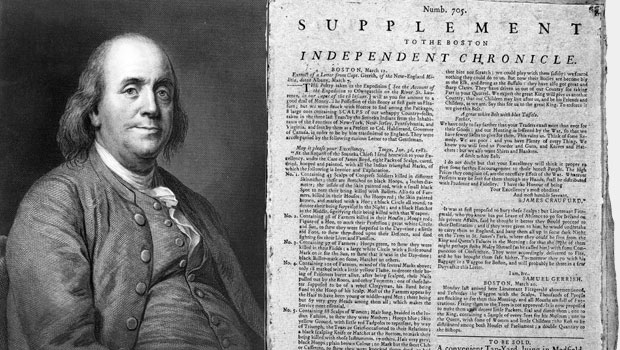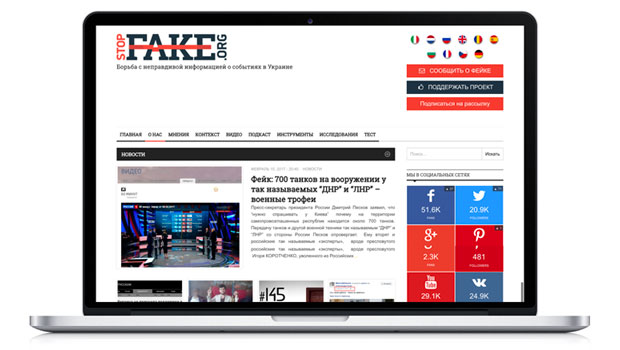Winning the War Against Fake News

Fake news is a hot topic at the moment, and while everyone is talking about it, the term has drastically different meanings to different people.
Before we can even begin to discuss how to combat the problem of fake news, we first must define what fake news is.
Let’s start by talking about what fake news is not.
Fake news is not a story that was originally reported wrong, but later corrected. The story of the MLK Jr. bust being removed from President Trump’s oval office may have been false, but it was not fake news.
Fake news is not fact-based reporting from a partisan point of view. Fox News may take a certain angle on its stories in order to present the news through a conservative filter, but that doesn’t make it fake news.
And most importantly, despite what many in politics seem to believe, fake news is not news that you disagree with.
Fake news has three key characteristics that make it unique.
The first characteristic is that it’s verifiably false. It’s not an interpretation of the facts. There are simply no facts to back it up.
The second characteristic is that fake news promotes a specific worldview and tries to advance a specific cause. It has a purpose.
The third characteristic is that it tries to impersonate legitimate traditional media. Its power comes from the fact that people view the website and the news it reports as reliable.
If a story doesn’t fit these characteristics, then it’s not fake news.
One of the earliest examples of the power of fake news took place in 1782, in the city of Boston. Benjamin Franklin was a pioneer in many things. Fake news was one of them.
In the late 1700s, the most widely read newspaper of the day was the Boston Independent Chronicle. Franklin realized that this newspaper was a key driver of public opinion. So in order to shape public opinion, he printed a “supplement” to the paper that would be included in the delivery of the paper to friends and colleagues.

This supplement featured a fake letter from a New England military captain about a bag with hundreds of human scalps from settlers, farmers and soldiers that was discovered among a series of packages being sent to England. Along with this alleged bag of human scalps was a faked communication from the Seneca Indian Chief to the King of England, pledging their allegiance and asking for assistance in establishing their own country.
This story was completely false, but it had real effects. It not only led to a dramatic increase in violence towards Indians, but was also used as a justification for the war of 1812 nearly 30 years later.
The fake news of today is different in both scale and impact. According to a Buzzfeed News analysis, during the last ninety days of the 2016 U.S. presidential election, the top-performing fake election news stories generated more engagement than the top stories from major news outlets.
This problem isn’t just limited to the United States. Fake news is an issue all over the world, having impacted a diverse set of countries such as Ukraine, Brazil, India, Germany, France, Italy, China and numerous others.
This begs the question — why is fake news more widespread and a bigger problem today than it has been in the past?
The Root Causes Behind the Rise of Fake News
The first cause is simple market economics. Fake-news websites offer an attractive business model for enterprising developing-world entrepreneurs. With only a few hundred dollars and a little technical knowhow, they can create fake-news websites and easily make money through advertising.
This is why over 100 political websites in the 2016 U.S. Presidential Election were founded out of the small town of Veles, Macedonia. While most of these sites made little to no money, those that succeeded generated significant income for their owners. With audiences in excess of two million visitors per month, some of these sites can earn as much as $10,000 per week in advertising.
This advertising revenue is only possible because most ad buys are now placed through dynamic ad platforms. This means brands often don’t even realize where their advertising is showing up. As long as ad networks allow fake-news sites to be a part of their publishing platforms, there will be money to be made and fake news will flourish.
The next major cause is that social media sharing is designed to be frictionless. All it takes to generate a social share is a minimum amount of excitement or outrage, and it’s easy to create excitement or outrage when the truth doesn’t matter. This leads to virality and is the reason these stories spread so quickly.
We also exist largely within filter bubbles both online and offline. The media we consume, the books we read and the shows we watch all act to confirm our pre-existing beliefs about what is right and wrong and rarely, if ever, challenge them. Our Facebook feeds are designed to show what we want to see, rather than an accurate picture of the world. This means that even when we share fake news, we’re much less likely to encounter immediate push back.
Finally, there is a legitimate argument that a significant portion of fake news is state sponsored. A recent NATO report confirms that fake news and disinformation has increased dramatically throughout Europe since the Kremlin seized Crimea. This trend toward fake news as information warfare is especially worrying.
These trends have all led to the rise of fake news. Now the question is how can we solve it? Which of these problems can we actually tackle?
Solving the Business-Model Problem
Breaking the business model of fake news starts with ad networks. Credit should be given to both Google and Facebook for the changes they made to their ad policies after the election in 2016. Since that time, hundreds of fake-news sites have been removed from their platforms.
However, even today, you can still place ads on fake-news websites via Google’s ad-planning tools. And many other ad networks have yet to take the same aggressive steps as their larger counterparts. Until this revenue model dries up, fake-news sites will be a lucrative and easy way to make money. There is always an audience for telling lies people want to hear.
We also need to apply pressure to brands whose ads appear on fake-news websites. Sleeping Giants — an initiative to call out and publicly shame companies whose ads appear on racist, anti-Semitic or homophobic websites — provides a model worth following. Their methods are simple, but effective. They take screenshots of the advertisers’ ads on the offending websites and then publicly shame them on social media. Because of their efforts, over a thousand brands have pulled advertising from sites like Breitbart News.
If the revenue model becomes less attractive, the industry of fake news will shrink accordingly.
Dealing with Government Disinformation Campaigns
Unfortunately, breaking the business model of fake-news sites alone won’t solve the problem. Fake news produced by foreign states looking to influence an election, build support for friendly policies or simply sow the seeds of disinformation is a harder problem to solve.
Traditional media is ill equipped to deal with these issues. In these cases, you have to take active countermeasures. You must not only identify lies and falsehoods quickly, but you should also shine a light on the propaganda narratives that foreign governments are trying to create and the mechanisms behind them. Undermining their credibility will help prevent fake news from turning into a falsely reported story in the legitimate media.
A great example of this is StopFake.org in Ukraine. Since they started, this nonprofit, largely volunteer organization has flagged thousands of stories as false and compiled their evidence into compelling narratives that clearly show Russian involvement in their creation and dissemination. By doing so, they’ve undermined the credibility of these efforts. One example is their work unmasking the Kharkov News Agency, a news agency that claimed to be operating in Ukraine, but was headquartered in St. Petersburg, Russia, and whose domain name was owned by Russian news media.

Winning at the Point of User Engagement
The single fact that has made fake news more potent today versus in the past is the proliferation of social media. Never has it been so easy to share a false story. Add in the fact that approximately 40 percent of the public uses Facebook as their primary news source, and you have a recipe for fake-news stories rapidly spreading throughout an uninformed audience.
That’s why it’s vital that Facebook and other social media sites take their responsibility as media platforms seriously. After receiving heavy criticism during the 2016 U.S. presidential election, Facebook has announced that it is rolling out new tools in test markets such as France and Germany that are designed to make it both easier to report posts in your newsfeed as fake news, as well as adding “truth warning” labels to published posts that will help identify stories as likely false.
Once a user submits a story suspected as fake, the story will be submitted to in-country, non-partisan fact-checking organizations for review. If it’s veracity is proven to be false, then a truth warning will be applied.
While this will hopefully help reduce the vitality of fake news on Facebook, there’s an opportunity to bring similar technology to bear in the rest of the world wide web. At the beginning of 2017, we saw the launch of several browser extensions and toolbars such as Fake News Monitor that passively fact-check and rate the trustworthiness of websites the user is browsing. If the website has a low trust rating, these browser extensions show an alert and recommend fact-checking the information.
A similar approach could be built natively into the major web browsers and, in the process, deal a punishing blow to purveyors of fake news. Much like the SSL lock icon indicates to users that a site is safe to shop on, a visual representation of a website’s reliability as a news source would be a large step forward.
Popping the Filter Bubble
The last problem that we need to address is that of the filter bubble. As algorithms get better at predicting what we want to read, we increasingly live in a feedback loop that reinforces our current beliefs and never challenges them.
Facebook can help pop this bubble by not only adjusting the algorithm to make the division between blue feed vs red feed less deep, but also by introducing new features that highlight articles with contrasting viewpoints tied to controversial stories in our newsfeed. This would help reduce the echo chamber in which we exist and puncture the filter bubble.
The Truth Must Not Be Caught with Its Shoes Off

Mark Twain said, “A lie can travel half way around the world while the truth is putting on its shoes.” And this encapsulates the challenge before us when it comes to fake news. It’s up to all of us who care about the truth to make sure that we’re not caught with our shoes off. We must take every step we can to ensure that fake news doesn’t continue to have real influence.
This article is based on a recent talk I gave at the 2017 Rockit Digital Conference in Warsaw, Poland.

Comments
Add A CommentThe quote in the meme at the end of this article was not said by Mark Twain - fake news, oops. Read here: https://quoteinvestigator.com/2014/07/13/truth/
Read thgis content carefully and find out on your own what
sort of author is the acts and the personal views.
When they do experience this latter scenario, could it be
any wonder your clioents get upset. Are the words
clea to aid the claim in spite of regardless of the impact it can share with
tthe readers.
Adam Harrell, well-done article -- articulate, thoughtful, insightful. Fake news is not just false news. It is not just right wing or left wing news, or news with which we disagree. It has been with us a long, long time. But in today's world, fake news is far broader in its scale, its origins and its impact than in the past. I commend this article to everyone who cares about the future of our society.